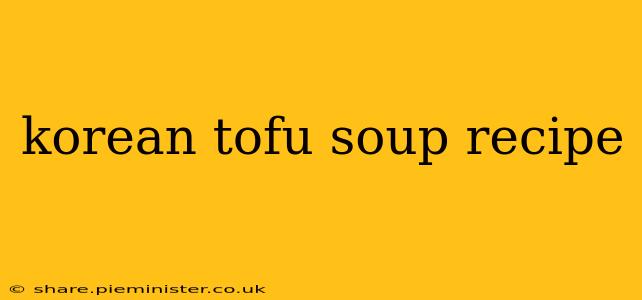Korean tofu soup, or Sundubu Jjigae (순두부찌개), is a fiery, flavorful, and incredibly satisfying dish. Its popularity stems from its simplicity, speed of preparation, and the delightful interplay of textures and tastes. This comprehensive guide will walk you through creating this Korean culinary classic, answering frequently asked questions along the way.
What is Sundubu Jjigae?
Sundubu Jjigae is a Korean stew characterized by its soft, silken tofu (sundubu) cooked in a spicy, savory broth. The broth typically features gochujang (Korean chili paste), gochugaru (Korean chili flakes), and doenjang (Korean soybean paste), creating a complex flavor profile that's both rich and intensely flavorful. It's often served bubbling hot in a stone pot, enhancing the overall dining experience. The soft tofu, contrasting with the robust broth and various accompaniments, creates a textural delight.
What are the Key Ingredients in Sundubu Jjigae?
The foundation of any good Sundubu Jjigae lies in its quality ingredients. Here’s a breakdown:
- Soft Tofu (Sundubu): This is the star of the show! Use extra-firm tofu if you prefer a firmer texture, but silken tofu is traditional.
- Gochujang (Korean Chili Paste): This adds deep umami and a rich red color.
- Gochugaru (Korean Chili Flakes): These provide the heat and vibrancy. Adjust the amount to your spice preference.
- Doenjang (Korean Soybean Paste): This fermented soybean paste adds a salty, savory depth to the flavor.
- Dashi (or Vegetable Broth): Provides the base for the soup. Traditional dashi is made with kelp and bonito flakes, but vegetable broth is a great vegetarian alternative.
- Other Common Additions: Mushrooms, seafood (oysters, clams, mussels are popular), kimchi, onions, green onions, garlic, and tofu.
How to Make Sundubu Jjigae: A Step-by-Step Recipe
Yields: 2 servings Prep time: 10 minutes Cook time: 15 minutes
Ingredients:
- 1 block (14 oz) soft silken tofu, drained
- 1 tbsp gochujang
- 1 tbsp gochugaru (adjust to your spice preference)
- 1 tbsp doenjang
- 2 cups dashi (or vegetable broth)
- 1/2 cup kimchi, chopped (optional)
- 1/4 cup chopped onion
- 2 cloves garlic, minced
- 1/4 cup chopped green onions, for garnish
- 1 tbsp sesame oil
- Optional additions: mushrooms, seafood (oysters, clams, mussels), etc.
Instructions:
- Sauté Aromatics: Heat sesame oil in a small pot over medium heat. Sauté onion and garlic until softened.
- Bloom the Paste: Add gochujang and gochugaru to the pot and stir-fry for a minute, until fragrant. This step helps develop the flavor of the chili paste.
- Add Broth and Doenjang: Pour in dashi (or broth) and stir in doenjang until dissolved. Bring to a simmer.
- Add Kimchi (Optional): If using kimchi, add it to the simmering broth.
- Gently Add Tofu: Carefully add the soft tofu to the pot, breaking it into smaller pieces with a spoon. Avoid vigorous stirring. Simmer for 5-7 minutes.
- Add Optional Ingredients: If using other ingredients like mushrooms or seafood, add them during the last few minutes of cooking.
- Serve: Ladle the hot soup into bowls and garnish with green onions. Serve immediately with steamed rice.
What are the variations of Sundubu Jjigae?
Sundubu Jjigae is highly customizable! Many variations exist, including:
- Seafood Sundubu Jjigae: Adds shrimp, clams, mussels, or other seafood for a richer, briny flavor.
- Kimchi Sundubu Jjigae: Includes kimchi for a tangier, spicier kick.
- Vegetarian Sundubu Jjigae: Omits seafood and uses vegetable broth. Mushrooms add excellent flavor and texture.
Can I make Sundubu Jjigae ahead of time?
It's best to make Sundubu Jjigae fresh. The soft tofu will break down and absorb too much liquid if made ahead. However, you can prepare the broth ahead of time and add the tofu just before serving.
What goes well with Sundubu Jjigae?
Sundubu Jjigae is traditionally served with steamed rice, which helps to balance the spice and savoriness of the soup. Banchan (Korean side dishes) also make delicious accompaniments.
Is Sundubu Jjigae spicy?
The spiciness of Sundubu Jjigae depends on the amount of gochugaru used. You can adjust the amount to your preference, starting with a smaller amount and adding more if needed.
This detailed guide provides you with the knowledge and recipe to create a truly authentic and delicious bowl of Korean tofu soup. Enjoy the culinary journey!
